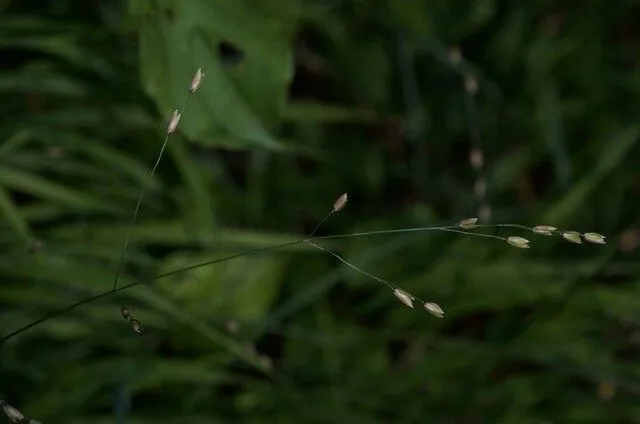
Author: Retz.
Bibliography: Observ. Bot. 1: 10 (1779)
Year: 1779
Status: accepted
Rank: species
Genus: Melica
Vegetable: False
Observations: Medit., Europe to Caucasus
Wood melick, known scientifically as Melica uniflora, is a notable species within the Poaceae family, often revered for its unique characteristics and significant ecological presence. First described by the botanist Retzius in 1779’s “Observationes Botanicae,” wood melick has established itself across a diverse range of habitats, spanning from the Mediterranean regions to the expanse of Europe and reaching as far as the Caucasus.
This perennial grass thrives in shaded woodland environments where it plays a crucial role in the understory vegetation. Its slender, arching stems and delicate, nodding flower spikes lend an elegant grace to forest floors and contribute to the biodiversity of these ecosystems. The plant’s ability to adapt to various soil conditions, particularly those that are well-drained and slightly acidic, allows it to flourish in both natural forests and managed woodland areas.
Wood melick is distinguished by its singular floral arrangement. The species name uniflora is derived from its characteristic solitary flowers, which form in loose, airy clusters. These flowers typically exhibit a subtle palette of greenish hues, sometimes tinged with purples and reds, that blend seamlessly into their verdant surroundings. The flowers are modest but significant, providing nectar and pollen for various forest insects, and further enriching the ecosystem around them.
Aside from its ecological importance, wood melick holds value in conserving soil and preventing erosion, thanks to its fibrous root system that binds the soil effectively in forested regions. Its presence is an indicator of good soil health and well-maintained woodland management practices.
Considering its wide geographic distribution, wood melick demonstrates a remarkable resilience and adaptability to different climatic conditions across its range. Botanists and ecologists often study this species to understand better plant responses to environmental changes and the dynamics of forest ecosystems.
Wood melick, with its graceful appearance and ecological value, remains a subject of interest for botanists and nature enthusiasts alike. Its continued study helps shed light on the complex interactions within forest ecosystems and emphasizes the importance of preserving such integral species for maintaining ecological balance.
Deu: einblütiges perlgras
Dan: enblomstret flitteraks
Nld: eenbloemig parelgras
Swe: lundslok
Fra: mélique uniflore
Eng: wood melick
Cym: melic-wellt y coed, melic-wellt y goedwig, meligwellt, meligwellt y coed, meligwellt y goedwig
En: Wood melick, Wood Melic
Bg: Едноцветна бисерка
Ca: Mèlica uniflora
Cs: Strdivka jednokvětá
Da: Enblomstret Flitteraks
Nl: Eenbloemig parelgras
Fi: Röyhyhelmikkä
Fr: Mélique uniflore, Mélique à une fleur
De: Einblütiges Perlgras
Ga: Meilic
It: Melica comune
Fa: ملیکای تکگل
Pl: Perłówka jednokwiatowa
Sv: Lundslok
Cy: Meligwellt y coed, Melic-Wellt y Coed, Melic-Wellt y Goedwig, Meligwellt, Meligwellt y Goedwig
Taken May 20, 2007 by Tela Botanica − Daniel MATHIEU (cc-by-sa)
Taken May 22, 2016 by Tela Botanica − Yoan MARTIN (cc-by-sa)
Taken May 22, 2016 by Tela Botanica − Yoan MARTIN (cc-by-sa)
Taken May 22, 2016 by Tela Botanica − Yoan MARTIN (cc-by-sa)
Taken Sep 5, 2022 by Patrice Bracquart (cc-by-sa)
Taken Apr 25, 2015 by Tela Botanica − Yoan MARTIN (cc-by-sa)
Taken Apr 25, 2015 by Tela Botanica − Yoan MARTIN (cc-by-sa)
Taken May 10, 2015 by Tela Botanica − Yoan MARTIN (cc-by-sa)
Taken Sep 5, 2022 by Patrice Bracquart (cc-by-sa)
Taken Sep 5, 2022 by Patrice Bracquart (cc-by-sa)
© copyright of the Board of Trustees of the Royal Botanic Gardens, Kew.
Taken May 16, 2022 by Fabrice Rubio (cc-by-sa)
Taken Oct 8, 2022 by Tristan Jaton-Maria (cc-by-sa)
Taken Jul 16, 2021 by Irmgard Groß (cc-by-sa)
Taken May 1, 2021 by j k (cc-by-sa)
Taken May 22, 2016 by Tela Botanica − Yoan MARTIN (cc-by-sa)
Taken Apr 22, 2022 by Juber (cc-by-sa)
Taken Sep 30, 2022 by Kai Best (cc-by-sa)
Taken Oct 8, 2022 by Tristan Jaton-Maria (cc-by-sa)
Taken Oct 8, 2022 by Tristan Jaton-Maria (cc-by-sa)
Taken Sep 30, 2022 by Kai Best (cc-by-sa)
Taken Jun 9, 2019 by Tela Botanica − Jean-Claude Bouzat (cc-by-sa)
Taken May 20, 2013 by Tela Botanica − John DE VOS (cc-by-sa)
Taken Apr 25, 2015 by Tela Botanica − Yoan MARTIN (cc-by-sa)
Taken Apr 25, 2015 by Tela Botanica − Yoan MARTIN (cc-by-sa)
Taken May 10, 2015 by Tela Botanica − Yoan MARTIN (cc-by-sa)
Taken Apr 18, 2013 by Tela Botanica − Marie PORTAS (cc-by-sa)
Taken Jan 1, 1800 by Tela Botanica − Daniel MATHIEU (cc-by-sa)
Taken Mar 31, 1882 by Tela Botanica − Anne-Marie GRIMAUD (cc-by-sa)
Taken May 9, 2020 by silvia darocha (cc-by-sa)
Taken May 9, 2020 by silvia darocha (cc-by-sa)
Ph maximum: 6.5
Ph minimum: 5.5
Light: 4
Atmospheric humidity: 5
Soil nutriments: 5
Family: Myrtaceae Author: (F.Muell.) K.D.Hill & L.A.S.Johnson Bibliography: Telopea 6: 402 (1995) Year: 1995 Status:…
Family: Rubiaceae Author: Pierre ex A.Froehner Bibliography: Notizbl. Bot. Gart. Berlin-Dahlem 1: 237 (1897) Year:…
Family: Sapindaceae Author: Koidz. Bibliography: J. Coll. Sci. Imp. Univ. Tokyo 32(1): 38 (1911) Year:…
Family: Asteraceae Author: A.Gray Bibliography: Pacif. Railr. Rep.: 107 (1857) Year: 1857 Status: accepted Rank:…
Family: Fabaceae Author: Medik. Bibliography: Vorles. Churpfälz. Phys.-Ökon. Ges. 2: 398 (1787) Year: 1787 Status:…
Family: Aspleniaceae Author: (Cav.) Alston Bibliography: Bull. Misc. Inform. Kew 1932: 309 (1932) Year: 1932…